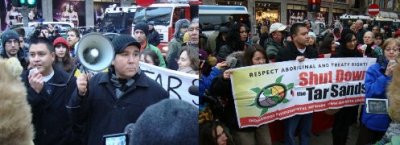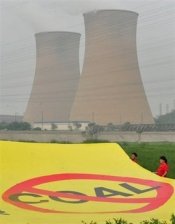The Indigenous Environmental Network Wins Grant |
Congressman James L Oberstar
Eighth Congressional District of Minnesota
Bemidji Group Receives Healthy Living Grant
Thursday, January 21, 2010
Washington DC – Congressman Jim Oberstar released the following statement today in response to the Robert Wood Johnson Foundation’s (RWJF) decision to grant a Bemidji organization $250,000 to fight childhood obesity among Native American children.
“The Robert Wood Johnson Foundation is fighting the most insidious epidemic to plague America’s children since our nation was ravaged by polio decades ago. Childhood obesity is rising exponentially in the United States. Thirty years ago, 6.5 percent of our children were obese; today, that number has nearly tripled. Childhood obesity is causing long-term health problems like diabetes and heart disease that will plague our children their entire lives and cause premature death.
In Bemidji, the RWJF is helping the Indigenous Environmental Network (IEN) combat this problem among Native American children. By working to increase access to healthy, local and wild foods, IEN can help our children learn healthy eating habits.
Earlier this month, the RWJF announced it would fund a statewide coordinator for the Safe Routes to School Program which helps communities find new ways to help kids walk and bike to school. In Congress, I was able to pass the Safe Routes to School legislation to develop programs across the nation, but the support of communities and nonprofits like RWJF is essential to making this program a success. Together, we are changing the habits of an entire generation so our children can grow up to be healthy and strong.”
Click here to read the full text of the RWJF press release on its Communities Creating Healthy Environments program. |
|
>>Carbon Markets Violate Indigenous Peoples’ Rights and Threaten Cultural Survival |
Indigenous leader kidnapped and forced at gunpoint to surrender carbon rights for REDD in Papua New Guinea
For More Information Contact:
Tom Goldtooth, Executive Director
Indigenous Environmental Network
(218)760-0442
New York, USA --- As carbon traders hawk permits to pollute at the Second Annual Carbon Trading Summit, Indigenous Peoples denounced that selling the sky not only corrupts the sacred but also destroys the climate, violates human rights and threatens cultural survival.
"Carbon trading and carbon offsets are a crime against humanity and Creation," said Tom Goldtooth, Executive Director of Indigenous Environmental Network. “The sky is sacred. This carbon market insanity privatizes the air and sells it to climate criminals like Shell so they can continue to pollute and destroy the climate and our future, rather than reducing their emissions at source.”
“This Carbon Traitors’ Summit comes on the heels of the failed UN Copenhagen climate conference which put forests in carbon markets by creating a mechanism called REDD or REDD-plus (Reducing Emissions from Deforestation and Degradation).” According to Goldtooth, “Most of the forests of the world are found in Indigenous Peoples’ land. REDD-type projects have already caused land grabs, killings, violent evictions and forced displacement, violations of human rights, threats to cultural survival, militarization and servitude.”
A recent World News Australia television exposé sheds light on the risks of REDD, carbon traders and the shocking kidnapping of a Papuan New Guinea native leader. Abilie Wape, a leader of the Kamula Doso Peoples claims he was forced at gun point to surrender the carbon rights of his tribe’s forest. Watch Video: CLICK HERE
A visibly shaken Wape told reporters, "They came and got me in the night… police came with a gun. They threatened me. They forced me to get in the vehicle. Then we came in the night to the hotel. They told me, “You sign. Otherwise, if you don’t sign, I’ll get a police and lock you up.”
"Indigenous Peoples are being forced to sign over their territories for REDD to the Gangsters of the Century, carbon traders, who are invading the world’s remaining forests that exist thanks to the knowledge of Indigenous Peoples,” denounced Marlon Santi, President of the CONAIE, the Confederation of Indigenous Nationalities of Ecuador, one of the most powerful native organizations in the world. “Our forests are spaces for life not carbon markets.”
Another REDD-type project, a UNEP-funded carbon forestry project in the Mau forest of Kenya has resulted in evictions and threatens the cultural survival of the Ogiek hunter-gathers. “Ordering us to leave Mau is like taking a fish out of water and expecting it to survive" said Ogiek People Development Program Director Daniel Kobei. According to REDD Monitor, “UNEP’s failure to prevent the eviction of thousands of people to make way for a carbon project…does not bode well for the millions of Indigenous Peoples and forest dwelling communities of the world.”
Survival International reports that REDD schemes could leave Indigenous Peoples “with nothing.” “Everyone who cares about our future, forests, Indigenous Peoples and human rights should reject REDD because it is irremediably flawed, cannot be fixed and because, despite efforts to develop safeguards for its implementation, REDD will always be potentially genocidal,” concluded Goldtooth.
El comercio de carbono viola los derechos de los Pueblos Indígenas y amenaza la supervivencia cultural (Word Doc)Líder indígena secuestrado, amenazado con armas y obligado a entregar los derechos al carbono de su selva para REDD en Papua Nueva Guinea
(PDF) |
|
>>Goldtooth: Raising the bar after Copenhagen |
By Tom B.K. Goldtooth
  The Indigenous Environmental Network took a delegation of 12 Native people from the United States and Canada to the 15th Conference of the Parties of the United Nations Framework Conference on Climate Change held in Copenhagen, Denmark the first two weeks in December. One message our delegation took to the international climate meeting called for stringent and binding emission reduction targets. The Indigenous Environmental Network took a delegation of 12 Native people from the United States and Canada to the 15th Conference of the Parties of the United Nations Framework Conference on Climate Change held in Copenhagen, Denmark the first two weeks in December. One message our delegation took to the international climate meeting called for stringent and binding emission reduction targets.
In accordance with the prescriptions of the Intergovernmental Panel on Climate Change, it requires all developed countries to take on reduction of greenhouse gas emissions by 2020 in the range of 25 to 40 percent based on 1990 levels. The U.S., one of the developed countries is by per capita a leading contributor to the greenhouse gases. Currently, U.S. climate legislation in both the House and Senate fail to meet these demands with reduction levels of only 3-4 percent by 2020 based on 1990 levels. At COP 15 another goal of IEN was to campaign for the world leaders to agree on a post-Kyoto Protocol binding emissions reduction target agreement.
There was no international legally binding agreement. There were no agreements by the U.S. or other developed countries on targets for reducing carbon emissions. Climate negotiations in Copenhagen resulted in a no agreement called the Copenhagen Accord. This accord has no real requirements for any countries to have reduction targets. The failure to achieve a real deal lies on the shoulders of rich countries whose pollution has caused the climate crisis – especially the U.S., European Union, Denmark and other industrialized countries. Rich countries refused to budge from the grossly inadequate emissions reduction proposals they brought to Copenhagen. Click here to continue reading.... |
|
>>Position Opening: Executive Director- Energy Action Coalition |
  The Energy Action Coalition is seeking a dynamic and self-motivated individual to join our team as the Executive Director. Energy Action Coalition has a central staff of 10 that coordinates our coalition of 50 organizations with 30+ funded staff in the field. The central staff is small and flexible in order to respond to the coalition's changing needs and variety of projects. The Energy Action Coalition is seeking a dynamic and self-motivated individual to join our team as the Executive Director. Energy Action Coalition has a central staff of 10 that coordinates our coalition of 50 organizations with 30+ funded staff in the field. The central staff is small and flexible in order to respond to the coalition's changing needs and variety of projects.
As Executive Director, you will be a key spokesperson and advocate for the Energy Action Coalition nationally and internationally. You will be responsible for representing the Coalition to media, funders and supporters, government, and other non-governmental organizations. You will provide strategic advice and support to Coalition campaigns, and will ensure that the campaigns are politically relevant. You will provide direction to the other members of the staff team and support the smooth functioning of the central staff. You will report to a newly formed Board of Directors, and will be the primary liaison between the Board of Directors and the Coalition. Click here to learn more about this and other positions open at Energy Action Coalition.
TO APPLY: Send cover letter and resume, including salary requirements to jobs@energyaction.net. Please include the job title in your email subject.
Energy Action Coalition is an equal opportunity employer with a commitment to engaging the skills and leadership of people of color, low-income persons, LGBT persons, differently-abled people, and other people from diverse backgrounds. People from these and other traditionally marginalized backgrounds and communities are strongly encouraged to apply. |
|
>>INDIGENOUS PEOPLES ASSEMBLY 2010 |

Friday, February 5 - Monday, February 8, 2010
Neskonlith, un-surrendered Secwepemc Nation
(so-called Chase, British Columbia, Canada)
Contact: nymcommunications@gmail.com
Weytk Xwexweytp. Greetings to the World.
The Secwepemc Peoples and the Native Youth Movement are inviting Indigenous Peoples throughout the Western Hemisphere and the World to come and join with us at an Indigenous Peoples Assembly at Neskonlith, un-surrendered Secwepemc Territory from Friday, February 5th to Monday,
February 8th, 2010.
Considering that we, as Indigenous Peoples, have continued to resist the invasion and destruction of our Water and Territories for 518 years. That the last of our remaining Lands, Water and Territories are being plundered and raped and that it is our duty and responsibility to defend Life by any means.
We understand that our common oppressor has used all tactics to try to exterminate our Indigenous Peoples and Ways and by doing this they are waging War on the Earth itself.
All Indigenous Peoples are encouraged to come and share their history, stories and struggles of Resistance, so we may begin to know each other and build our alliance and unity of Resisting Red Nations.
At the time of this Indigenous Peoples Assembly, so-called British Columbia and Canada will be in the global spotlight, with the 2010 Winter Olympic Games taking place just days away in the neighboring Indigenous Nations of un-surrendered Coast Salish and St’at’imc Territories.
It will be an opportunity for Us, as Indigenous Peoples, to come together to send a clear and unified message and let our Struggles be known Worldwide.
We also call on all Indigenous Peoples and Peoples of the World to attend the 2010 Convergence, the mobilization against the 2010 Winter Olympic Games from February 10-15, 2010 in Vancouver, un-surrendered Coast Salish Territories.
All Indigenous Peoples, Communities and Nations are invited to demonstrate their clothing, songs, dances, and other traditional forms of expression, both at the Indigenous Peoples Assembly and the 2010 Convergence.
To get directions, discuss travel information and confirm attendance contact: nymcommunications@gmail.com
To make a donation to the Indigenous Assembly contact: Secwepemc Nation Youth Network: snyouthnetwork@hotmail.com
To get more information about the 2010 Convergence contact: olympicresistance@riseup.net |
|
>>Support CSTC Opposition to the Enbridge Pipeline & Joint Panel Review |

Dear Chiefs and Councilors,
The Carrier Sekani Tribal Council (CSTC) is comprised of 8 First Nations in north central B.C. Our territories account for 7.8 million hectares of unceded lands and water. Our people have lived here since time immemorial. We have not given up our inherent Aboriginal rights to make decisions in our territory to any government through force or negotiation. We have also not been properly consulted on processes proposed by the Crown that have significant impacts to our ability to make land and natural resource use decisions.
There are several proposals to construct pipelines through our territories. We are particularly concerned with the recent decision by the government of Canada to proceed with a Joint Panel Review of the proposed Enbridge Northern Gateway Project. The CSTC is not supporting the process, or the idea of having 36 inch pipelines carry toxic oil and condensate cross our lands and waterways. In 2006 the CSTC conducted an Aboriginal Interest and Use Study (AIUS) examining the impacts of the same type of pipeline project proposed by Enbridge. Our people said the risks to our lands and water was too great for such a project. We think you will agree with us.
Enbridge's proposed Northern Gateway Project could entail the construction of two parallel pipelines from Alberta's oil sands, bisecting B.C.'s central interior, cutting across most of the salmon bearing portion of the Nechako watershed, before entering the Skeena watershed and terminating in Kitimat (total of 1170kms, 670km in BC). A 36 inch pipe is proposed to carry an average of 525,000 barrels of pressurized oil sands petroleum to Kitimat, where it will be transported by super tankers through printing coastal zones. A 20 inch pipe will carry an average of 193,000 barrels of condensate per day, a highly toxic substance used to dilute the oil sands petroleum slurry so that it can be transported via the pipeline. The right-of-way required is estimated at 30 metres.
The project is intended to facilitate increased production from the Athabasca oil sands, which is considered one of the dirtiest forms of oil and Canada's main contributor to climate change. During the recent UN climate change discussions in Copenhagen, the Canadian government was publicly shamed for its role in subsidizing the continued oil sands development. 'Canada's Dirty Oil Shame' is threatening to increase north coast tanker traffic, creating a new risk to marine and aquatic life. It is only a matter of 'when' an accident will cause untold amounts of oil and or condensate to spill.
The proposed Enbridge pipeline will only create a few short-term, specialized jobs. Any proposed long term financial gains will be offset by the direct cumulative impacts of creating another linear corridor through our territory. Compounded by the impacts from the mountain pine beetle in festation, the Enbridge pipeline will cross 785 water courses, posing additional risk to already fragile and fragmented wildlife and fish habitat.
Our people, like many other First Nations people have relied on the resources provided by the land and water for generations. We believe that all First Nations should be concerned with the Enbridge pipeline proposal because it will impact fish habitat and risk the further decline of fish stocks in the Stuart, Nechako and ultimately the Fraser Rivers. The CSTC First Nations have not been given an equal opportunity to properly manage the resources in our territories, nor have we been part of creating processes that reflect our inherent right to make joint decisions with the Crown.
The project is currently being reviewed by the Canadian Environmental Assessment Agency (CEAA) via a Joint Review Panel Process (JPRP). This process cannot adequately deal with our Aboriginal rights, and is not the venue for consultation the CSTC communities are seeking. Like the BC Environmental Assessment Process, the JPRP is antiquated. CSTC and its member First Nations have been calling on a separate First Nations review process of these mega projects. Only then can our rights be properly included in deciding if such projects should occur.
If you wish to obtain additional information about the proposed Enbridge pipeline, please visit the CSTC website (http://www.cstc.bc.ca/cstc/49/oil+gas++pipelines). There you will find information regarding the impacts of the Enbridge pipeline proposal, First Nations perspectives on Environmental Assessments and other related resources.
If you agree that the risks this proposal poses to the fisheries resources of the Fraser outweigh any potential benefits, please email jfindlay@cstc.bc.ca and we will include you on a contact list for continued communication on this matter as the CEAA process continues.
Sincerely,
CARRIER SEKANI TRIBAL COUNCIL
DAVID LUGGI
Tribal Chief |
|
>>Will You Be a Victim of Killer Coal? |
  Thursday 21 January 2010 Thursday 21 January 2010
by: Joshua Frank, t r u t h o u t | News Analysis
So, you thought inhaling glue or driving without a seatbelt was bad for your health? Try living next to a coal-fired power plant.
That's the diagnosis that Physicians for Social Responsibility (PSR) relayed to the public in a comprehensive medical study released on November 18, 2009, called "Coal's Assault of Human Health." In it, the organization, comprised of physicians and public health experts, claimed that coal
pollutants damage every major organ in the human body and contribute to four of the top five leading causes of death in the United States.
"The findings of this report are clear: while the U.S. relies heavily on coal for its energy needs, the consequences of that reliance for our health are grave," said Dr. Alan H. Lockwood, a principal author of the report and a professor of neurology at the University at Buffalo.
It is not simply about cleaning up the coal process; it is about halting its production altogether in order to immediately save lives - an estimated 24,000 every single year.
At every stage in its life cycle, coal can negatively impact human health, from mining operations, cleaning, transportation to burning and disposing of the combustion waste. PSR reported that many Americans are being affected daily by coal and the exposure is contributing to horrible health problems; heart attacks, lung cancer, strokes and asthma, among others. Click here to read the rest of the article. |
|
>>Lawsuit to Be Filed to Stop Pollution at Proposed PolyMet Mine Site |
For Immediate Release, January 25, 2010
Contact: Marc Fink, Center for Biological Diversity, (218) 525-3884
  DULUTH, Minn.— The Center for Biological Diversity, Save Lake Superior Association, and the Indigenous Environmental Network today filed formal notice that they intend to file suit against mining company Cliffs Erie to stop the ongoing pollution of waters that surround the proposed PolyMet mine site. According to Cliffs Erie’s own monitoring reports, there are numerous ongoing violations of water-quality laws relating to management of the former LTV tailings basin. PolyMet’s proposal for its copper-nickel mine is to pile its own tailings waste on top of those from a former taconite mine that are still polluting. The 60-day notice letter is a prerequisite to filing a citizen enforcement action under the Clean Water Act. DULUTH, Minn.— The Center for Biological Diversity, Save Lake Superior Association, and the Indigenous Environmental Network today filed formal notice that they intend to file suit against mining company Cliffs Erie to stop the ongoing pollution of waters that surround the proposed PolyMet mine site. According to Cliffs Erie’s own monitoring reports, there are numerous ongoing violations of water-quality laws relating to management of the former LTV tailings basin. PolyMet’s proposal for its copper-nickel mine is to pile its own tailings waste on top of those from a former taconite mine that are still polluting. The 60-day notice letter is a prerequisite to filing a citizen enforcement action under the Clean Water Act.
“Before the state even considers the approval of a new wave of mining in northeastern Minnesota, it should first require the mining companies to clean up the pollution from past taconite mines,” said Marc Fink, an attorney with the Center for Biological Diversity. “As we all learned as kids, you should clean up one mess before making another one.”
The LTV basin, located six miles north of Hoyt Lakes, was used for taconite tailings from the 1950s until 2001. The unlined basin is the source of numerous seeps and discharges of polluted wastewater into groundwater and surface waters, which eventually reach the Embarrass River. For the proposed NorthMet mine, PolyMet proposes to process more than 225 million tons of ore at the LTV processing facility, and use the same LTV tailings basin already known to be leaking.
“While past mining has already polluted these waters, the proposed heavy metals mining would bring severe new threats of pollution to these waters, which ultimately flow into Lake Superior at the Duluth harbor,” said Le Lind of the Save Lake Superior Association. “This new threat includes sulfuric acid runoff and higher levels of mercury in waters that are already impaired.”
In addition to the LTV site, the groups intend to file suit to stop ongoing pollution at the Dunka mine site, which is close to where Duluth Metals has plans for a copper-nickel mine adjacent to the Kawishiwi River, and where Franconia Minerals proposes a copper-nickel mine at the bottom of Birch Lake. Both the Kawishiwi River and Birch Lake flow into the Boundary Waters.
“These are historic tribal lands where the tribes retain treaty rights, and many tribal members are deeply concerned about additional pollution to fishing streams and sources of wild rice,” said Marty Cobenais of the Indigenous Environmental Network.
The groups are represented by attorney Charlie Tebbutt and Marc Fink, an attorney with the Center for Biological Diversity who resides in Duluth.
Click here to read more....
The Center for Biological Diversity is a national, nonprofit conservation group with more than 255,000 members and online activists dedicated to the protection of endangered species and wild places. |
|

Click here to get involved.
Upcoming Events
April 20, 2010 - April 22, 2010
April 04, 2010 - June 20, 2010
February 13, 2010 - May 09, 2010
|
|
|
|
>>RIGHTS: U.N. Condemns Land Grabs in Native Territories |
By Haider Rizvi
UNITED NATIONS, Jan 14, 2010 (IPS) - Millions of people around the world who belong to indigenous communities continue to face discrimination and abuse at the hands of authorities and private business concerns, says a new U.N. report released here Thursday.
It is happening not only in the developing parts of the world but also in countries such as the United States, Canada, Australia and New Zealand, which champion the causes of human rights and democracy, the report says.
Despite all the "positive developments" in international human rights setting in recent years, the study's findings suggest that indigenous peoples remain vulnerable to state-sponsored violence and brutality, which is often aimed at confiscating their lands.
"Governments and the United Nations need to be serious about this," said Victoria Tauli-Corpus, chairperson of the U.N. Permanent Forum on Indigenous Issues, an advisory body that works with the 54-member Economic and Social Council, after launching the report.
The 222 page-report, entitled "State of the World's Indigenous Peoples", points out that an overwhelming majority of the indigenous population is condemned to live in extreme poverty. Its authors noted that while indigenous peoples are around five percent of the world's population, they comprise 15 percent of people living in extreme poverty.
Click here to finish reading this article. |
|
>>Coal's Assault on Human Health |

by Ken Ward Jr.
CHARLESTON, W.Va. -- Coal pollution is assaulting human health through
impacts on workers, residents near mining operations and power plants, and the environment in coalfield communities, according to a new report by a group of physicians.
The report by Physicians for Social Responsibility examined coal's impacts
on major organ systems of the human body, from the lungs to the brain.
"The findings of the report are clear: While the U.S. relies heavily on coal
for its energy needs, the consequences of that reliance for our health are
grave," said Dr. Alan J. Lockwood, a University of Buffalo neurologist and
principal author of the report.
The 65-page report, released Wednesday morning, notes that coal provides
nearly half of the nation's electricity "and is a significant contributor to
economic development, a higher standard of living, and an increased life
expectancy."
But, coal combustion releases mercury, particulate matter, nitrogen oxide,
sulfur dioxide and dozens of other substances known to be hazardous to human
health. The report, "Coal's Assault on Human Health," looks at the cumulative harm inflicted by those pollutants on the respiratory system, the cardiovascular system and the nervous system. Click here to continue reading.... |
|
>>Tar Sands-Worlds Biggest Climate Crime |
By Clayton Thomas-Muller
Tar Sands-Worlds Biggest Climate Crime-Published originally in Left Turn Magazine......
Often when one looks at the global climate crisis and the critical necessity of forests as carbon storehouses, we have visions of the Amazon rainforest in South America, or the vast rainforest cover in places like Malaysia, Indonesia, across south East Asia and Africa. What many don’t envision is the second largest carbon storehouse on Mother Earth located in Canada’s northern region known as the Boreal Forest.
This soggy, wet, biologically diverse region spreads across the continent east to west. It is home to hundreds of First Nations/Indigenous communities that have utilized these ecologically diverse regions for their livelihood from time immemorial. Many also do not know that the Boreal Forest is second only to the Amazon region in terms of daily forest loss due to industrial expansion. This tree loss is further exacerbated by an infestation of the spruce pine beetle, brought on by milder winters in the north, which has been destroying millions of hectares of trees from southeast Alaska all the way to western Alberta.
Also found beneath the pine-covered ground are vast stores of minerals and fossil fuel deposits, the most famous of which is known as Canada’s Athabasca Tar Sands in Northern Alberta. Second only to Saudi Arabia in terms of recoverable oil reserves, Canada’s tar sands have an estimated 177 billion barrels of recoverable oil. The main difference between these two sources is the fact that the tar sands in Canada are not a conventional form of oil; they are a tarry clay and sand like mixture that at room temperature is hard as a hockey puck.
To remove this oil, one of two methods must be used. The first is surface mining, where industry removes the top layer of muskeg, trees, clay and sand as well as lakes, streams and even rivers to depths of up to 300 feet. They then use the world’s largest steam shovels, earth movers and dump trucks (300 tons per load) to strip mine out the mix that is then hauled off to industrial upgrader facilities and processed into synthetic oil. In the end it works out to around 5 tons of earth for every barrel of oil. Every day they move enough earth to fill the famous home of the Toronto Blue Jays, the Rogers Sky Dome.
If the deposits are more than a depth of 300 feet, producers must use a deep well injection process called “In Sutu” or Steam Assisted Gravity Drainage (SAG-D). This process is six times more carbon and water intensive then conventional oil extraction. The industry must also utilize vast amounts of natural gas to superheat fresh water to be injected into Mother Earth to “melt” the bitumen that then is sucked out of the ground with uptake pipes for upgrading. Click here to continue reading.... |
|
>>Talking about the tar sands in Copenhagen |
Clayton Thomas-Muller is with the Indigeneous Environmental Network. He was one of 20 First Nations delegates to the climate summit. The tar sands were on the top of his agenda. He explains why. Click here to listen. |
|
>>Seven Priorities for EPA’s Future |

MEMORANDUM
From: Lisa P. Jackson, Administrator
Almost one year ago, I began my work as Administrator. It has been a deeply fulfilling 12 months and a wonderful homecoming for me. As our first year together draws to a close, we must now look to the tasks ahead.
In my First Day Memo, I outlined five priorities for my time as Administrator. We have made enormous strides on all five, and our achievements reflect your hard work and dedication. By working with our senior policy team, listening to your input and learning from the experiences of the last 12 months, we have strengthened our focus and expanded the list of priorities. Listed below are seven key themes to focus the work of our agency. Click here to read the rest of the memorandum. |
|
>>Lawsuit to Be Filed to Stop Pollution at Proposed PolyMet Mine Site |
The Indigenous Environmental Network (IEN) and the Health Care Without Health Campaign HCWH) congratulates the United State Environmental Protection Agency (EPA) for negotiating an agreement between manufacturers and importers to voluntarily phase out the use of decabromodiphenyl ether (decaBDE), a brominated flame retardant. The phase-out represents a victory for public health and follows a decade-long effort by the Electronics Take Back Campaign, Health Care Without Harm, IEN Minnesota Healthy Legacy Project, and many other organizations to have the substance removed from the marketplace.
IEN congratulates the HCWH campaign that has been active for many years, working with Group Purchasing Organizations (GPOs) and leading hospital systems to move the healthcare sector’s purchasing away from brominated flame retardants.
Click here to see the press release from HCWH congratulating EPA for this agreement and outlining future work on chemicals and reform of the Toxic Substances Control Act. |
|
|